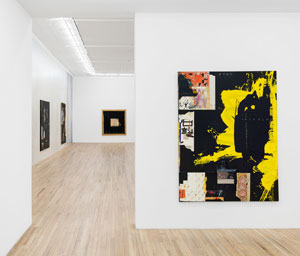Raymond Saunders casts a long shadow. He cannot help it, not in a two-gallery show where the shadows will not stop coming, all but decimating the walls. Its layers keep coming, too, in oil, graphite, enamel, oil pastel, and plenty of pasted paper.
Unlike Anthony Dominguez, he is anything but an outsider, except perhaps to New York. Yet he, too, found his art waiting for him on the street. For him, that meant not its hidden corners and subterranean passages, but on boarded-up buildings and in the air. And I bring this together my report on Dominguez as a longer review and my latest upload.
For Saunders the details accumulate, in years of found objects, frail scraps, and paint—to the point that one can neither put a name on the shadows nor dismiss them. They may lurk in the background, as shadows in the shadows, or seemingly leap right off the canvas, aiming for you. Should you start in Tribeca, a shadowy figure does both just as you come in, at Andrew Kreps through March 30. You may find yourself poring over the clues, there and at David Zwirner in Chelsea through April 6, to see where they lead. If you never do find out, try not to blame yourself. That first shadow is watching.
Black may be his favorite color, but it is not his only color. That figure’s bright yellow face and shock of hair would be hard to overlook even if the rest of his body were not hunched within a loose black coat. But then the yellow continues unbroken behind him—and the blackness returns behind that. Saunders loves reversing expectations, including the expectation that the ground must be white. He must like, too, undermining the distinction between painted image and ground. Works hang on the wall and serve as walls themselves.
Black may function as a ground for fields of color, like that yellow or a tart reddish pink. It may serve, too, as a playground for his impulses, in chalk scrawl. Numbers in that shadowy first painting run horizontally, as if to count the seconds, while a tribute to Charlie Parker reads Bird above a poignantly small photo. Approaching ninety, Saunders is old enough to remember when chalkboards, meaning blackboards, were black. Above all, a painted surface may serve for whatever he cares to find, whether advertisements or warnings. He calls the show “Post No Bills,” after a 1968 painting and the image it contains, but then he has no qualms about breaking the rules, including his own.
The show has more room to run through his violations in Chelsea. His methods suggest graffiti, but he is defacing only himself. It returns him to the streets, and his quotations are decidedly urban. Like black, they also allude to his status as an African American. While the LA artist has had little exposure in New York, he is at home enough to borrow a delightfully nasty front page from the city’s once-stellar alternatively weekly,  The Village Voice. You may have forgotten whatever scandal, but he has not.
The Village Voice. You may have forgotten whatever scandal, but he has not.
The references can be inscrutable, especially compared to the text art and political art of his time. You may dismiss his collage on one visit as a waste of good waste, see it on another as dazzling. (I did the first on catching him in LA art at MoMA PS1 in 2013, and look now.) Still, he will always have a firm reference point in the shadows and himself. An artist’s palette is just an illusion, but brushes are real enough, as if painting themselves. They are also black.
His favorite or not, “Black Is a Color,” as his 1967 manifesto has it. I can only wish that a formalist like Ad Reinhardt had adopted it as a motto, but Reinhardt died two years before. Like a Minimalist himself, Saunders works with monochrome and the space as well. He covers some walls in his tar-like black. He cloaks others in a caked white that is already coming off the wall. Naturally the cracks are black.
Read more, now in a feature-length article on this site.
